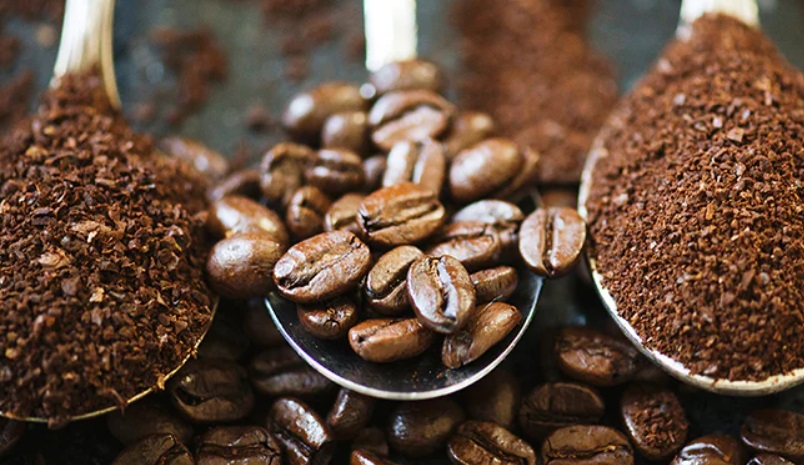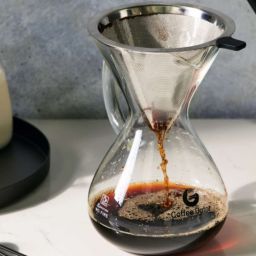
Dark roast coffee, as the name suggests, refers to coffee beans that have been roasted for a longer period compared to lighter roasts. This extended roasting time at higher temperatures results in beans that are dark brown to almost black in color, often with a shiny, oily surface. The flavor profile of dark roast coffee is robust and bold, with the roasting process bringing out smoky and toasted notes that dominate the more subtle flavors of the bean’s origin.
Key Takeaways on Dark Roast Coffee
- Bold and Smoky: The flavors of dark roast coffee are bold and smoky, often with hints of chocolate or caramel. This intense flavor can sometimes mask the more nuanced flavors inherent to the coffee bean itself.
- Lower Acidity: Compared to lighter roasts, dark roast coffee generally has lower acidity. This makes it easier on the stomach, providing a smoother drinking experience.
- Slightly Less Caffeine: While the difference is minimal, dark roast coffee typically contains slightly less caffeine than lighter roasts due to the longer roasting process.
- Versatility in Brewing: Dark roast coffee is versatile in its use, performing well across various brewing methods. It’s particularly favored in making espresso due to its bold flavor and creamy consistency when brewed.
Detailed Exploration of Dark Roast Coffee
Roasting Process
Dark roast coffee is crafted through a meticulous roasting process that deeply influences its character and flavor. The process begins with green coffee beans which are heated in a roaster. As the temperature inside the beans rises, they undergo a transformation known as the “first crack,” where they expand and make a distinct cracking sound. Dark roast beans are taken beyond this first stage to what is referred to as the “second crack.”
This second phase is key to achieving the dark roast’s signature attributes—it occurs at a higher temperature and results in a bean that’s darker with oils visibly coating the surface. The precise timing of stopping the roast after the second crack is crucial to avoid a burnt taste while ensuring the rich, deep flavors dark roast is loved for.
Flavor Profile
Dark roast coffee is renowned for its bold, rich flavors. Common tasting notes include chocolate, caramel, and various nutty undertones. These robust flavors are a result of the caramelization of sugars and the breakdown of fibers within the beans during the prolonged roasting process.
Unlike lighter roasts, which aim to preserve the unique characteristics and acidity of the coffee bean, dark roasts offer a uniform flavor profile that emphasizes a full-bodied and smoother taste. This makes dark roast a favorite among those who prefer their coffee less acidic and with a hearty, comforting flavor.
Caffeine and Nutritional Content
There’s a common misconception that dark roast coffee packs more caffeine due to its strong flavor. However, the truth is somewhat counterintuitive. During the roasting process, caffeine content diminishes slightly; hence, dark roasts typically have less caffeine than lighter roasts when measured by volume.
In terms of nutritional content, all coffee offers some essential nutrients, including antioxidants. Dark roast coffee, in particular, is noted for its high levels of N-methylpyridinium, an antioxidant not found in high amounts in lighter roasts. This compound is created during the roasting process and can help improve stomach acid production, making dark roast coffee easier on the stomach.
Brewing Methods: Best Ways to Brew Dark Roast Coffee
Dark roast coffee, with its robust flavors and oily surface, pairs exceptionally well with various brewing methods that highlight its unique characteristics. Here are some effective ways to brew dark roast coffee:
French Press: One of the best methods for brewing dark roast coffee is the French press. This method allows the coffee to steep directly in boiling water for several minutes, which helps to extract the deep, rich flavors inherent in dark roast beans. The French press also does not use a paper filter, which means the natural oils and full body of the coffee are not stripped away during the brewing process.
Espresso: Espresso is another excellent method for dark roast coffee. The high pressure of an espresso machine extracts the intense flavors and creamy body of dark roast beans very efficiently. Espresso brewing accentuates the chocolate and caramel notes typical of dark roast coffee, making it a popular choice for those who enjoy a strong, flavorful cup.
Pour Over: While typically associated with lighter roasts, the pour-over method can also enhance the smoother aspects of dark roast coffee. Using a fine grind and pouring the water slowly can help to reduce the bitterness and bring out the subtler flavors, like nuttiness or mild fruit notes, which are often overshadowed in other brewing methods.
Cold Brew: Cold brew is an excellent choice for dark roast coffee, especially if you’re looking to minimize acidity. This method involves steeping coffee grounds in cold water for an extended period (usually 12 hours or more), which produces a smooth, sweet, and concentrated coffee. The inherent boldness of dark roast coffee translates well into a cold brew, providing a refreshing and potent drink.
Common Uses: How Dark Roast Coffee is Utilized
Dark roast coffee is versatile, making it a favorite in various coffee preparations beyond just a standard brew:
Espresso Drinks: Dark roast coffee is famously used in espresso, which serves as the base for many other drinks, such as lattes, cappuccinos, and Americanos. The strong base of espresso made from dark roast beans ensures that the coffee’s flavor is not lost even when diluted with milk or water.
Drip Coffee: In many cafes and households, dark roast coffee is the go-to choice for drip coffee machines. Its bold flavor and lower acidity make it a preferred option for a comforting, everyday cup that stands up well to cream and sugar.
Blended Drinks: Dark roast coffee is also commonly used in blended coffee drinks. Its robust flavor can complement various ingredients like chocolate, spices, and syrups, making it an ideal choice for mochas or spiced coffee recipes.
FAQs
Is dark roast coffee stronger?
Despite its robust flavor, dark roast coffee is not necessarily stronger in terms of caffeine content. In fact, dark roast typically has slightly less caffeine than lighter roasts because caffeine diminishes slightly during the roasting process. The perception of strength comes from its bold, smoky flavor profile and lower acidity, which can give it a more pronounced taste.
Can the bitterness of dark roast coffee be too overpowering?
While dark roast coffee is known for its bold and sometimes bitter flavor, whether it’s overpowering depends on the brewing method and personal taste. To minimize bitterness, ensure proper brewing time and consider using a slightly coarser grind. Adjusting the water temperature slightly below boiling can also help reduce bitterness.
How should dark roast coffee beans be stored?
To preserve the freshness and flavor of dark roast coffee beans, store them in an airtight container in a cool, dark place. Avoid exposure to excessive air, light, and moisture. It’s best not to store coffee in the refrigerator or freezer as the fluctuating temperatures can cause condensation and affect the taste.
Are there health benefits specific to dark roast coffee?
Dark roast coffee contains essential nutrients and antioxidants, similar to other roasts. It has a higher concentration of N-methylpyridinium, an antioxidant that can help improve stomach acid production and potentially make it easier on the stomach. Overall, dark roast coffee offers similar health benefits to other coffee roasts, including improved mental alertness and potential heart health benefits.
Final Thoughts
In this exploration of dark roast coffee, we’ve uncovered that its appeal lies not just in its bold, enticing aroma but also in its versatile brewing potential and rich flavor profile. Dark roast coffee, with its smoky, chocolate, and caramel notes, offers a robust base for both straight shots of espresso and creamy, blended drinks. Its low acidity and smoother taste profile make it a favorite among coffee enthusiasts who prefer a hearty, comforting cup.









